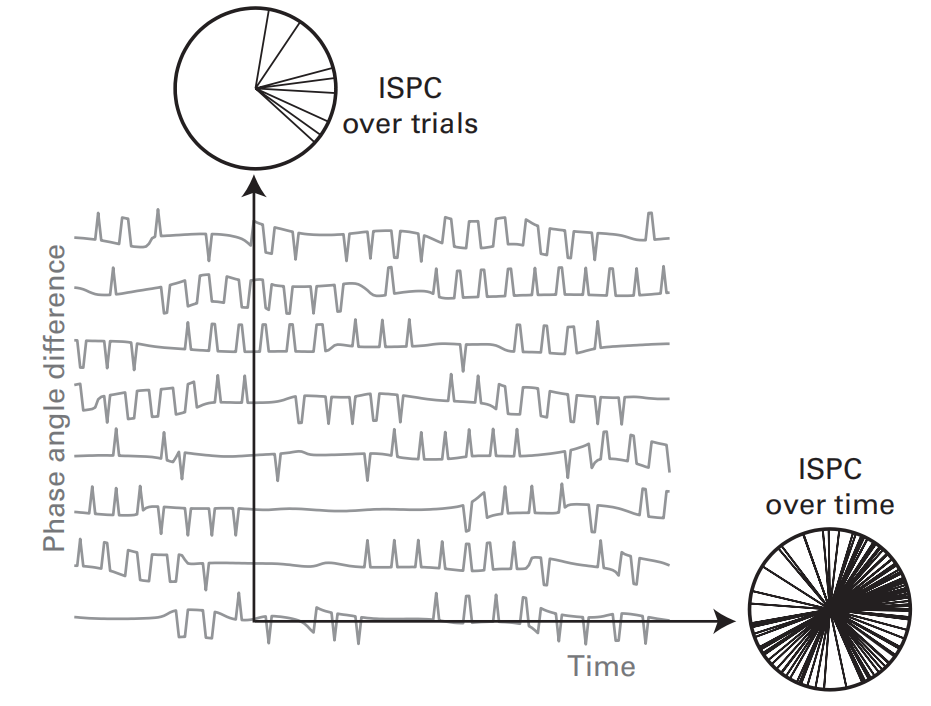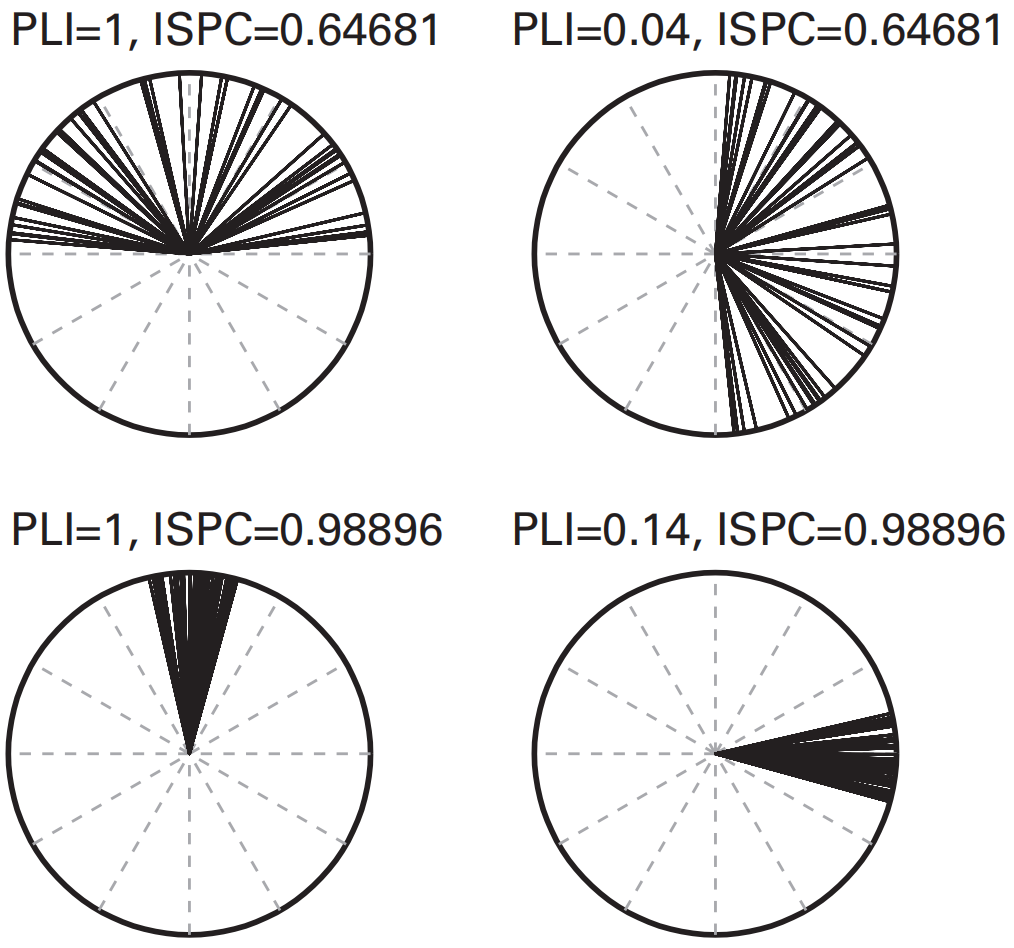Part 4 Connectivity | 功能连接分析
Chap.25 Introduction to the Various Connectivity Analyses
- Connectivity:指在同一时刻下考虑多个信号的分析。
- 需区分的概念:
- functional connectivity:linear or nonlinear covariation between fluctuations in activity recorded from distinct neural networks. 更接近于相关性(correlation)
- effective connectivity:a causal influence of activity in one neural network over activity in another neural network. 更接近于因果关系(causation)
- 两个电极之间的连接性(connectivity)可以反映不同大脑区域之间的真实连接,也可能是由于这两个电极测量了来自同一脑源的活动。
Chap.26 Phase-Based Connectivity
ISPC (Intersite phase clustering)
ISPC是一种用以描述基于相位的功能连接的方法,与ITPC相似,但计算的是两电极之间随时间或试次变化的相位角差的平均值
其中 n 是时间点数目或试次数目,$\phi_x$ 和 $\phi_{y}$ 是电极 x 和 y 在频率f下的相角,t是时间点或试次。
- ISPC反映的不是两电极相位差的大小,而是相位差随时间或试次的一致性
- ISPC是无向的(A→B的ISPC和B→A的相同)
ISPC-time and ISPC-trial
通过上面的公式,我们可以得到的是在一个时间窗口内一个试次的ISPC,如果有多个试次,而且我们想要得到ISPC随时间/试次的变化,可以采用如下方法:
ISPC-time:设置一个滑动的小时间窗,计算单个试次在每个时间窗下的ISPC(类似于short-time FFT),得到多个试次下的ISPC随时间的变化,最后再进行试次平均,得到ISPC在不同时刻下的值。小时间窗的长度选取规则类似于wavelet中the number of cycles的选取。
ISPC-trials:关注某一时间点下不同试次的相位差大小。ISPC-trial所反映是在不同的试次下,两电极间的相位差是否能保持一致,其值越大,说明相位差在不同试次下越能保持一致。
对试次的数目比较敏感,试次数目需要足够多,才能获得稳定的结果
如果在不同实验条件下的试次不同,可以考虑使用 weighted ISPC-trials (wISPC-trials),其原理与 wITPC 相近。
计算时的区别:
ISPC-time:先在滑动时间窗内时间平均,最后试次平均
ISPC-trial:在不同时间点下进行试次平均

Matlab代码实现:
% 对于频率,通常采用对数分布
freqs2use = logspace(log10(4),log10(30),15); % 4-30 Hz in 15 steps
% 非频率值,可以采用线性分布,timewindow的宽度是下面取值的两倍
timewindow = linspace(1.5,3,length(freqs2use)); % number of cycles on either end of the center point (1.5 means a total of 3 cycles))ISPC-time (ispc) 和 ISPC-trial (ps) 的计算:
for fi=1:length(freqs2use)
% phase angle differences(维度为time×trials)
phase_diffs = phase_sig1-phase_sig2;
% compute ISPC over trials(trial平均,时间没有平均,所以ps的是"频率×时间"的矩阵)
ps(fi,:) = abs(mean(exp(1i*phase_diffs(times2saveidx,:)),2));
% 计算每一个时间点(timewindow中点)下的ISPC
for ti=1:length(times2save)
% compute phase synchronization(ISPC-time,每个时间窗可计算出一个值,1×trial)
phasesynch = abs(mean(exp(1i*phase_diffs(times2saveidx(ti)-time_window_idx:times2saveidx(ti)+time_window_idx,:)),1));
% average over trials(trial平均)
ispc(fi,ti) = mean(phasesynch);
end
end % end frequency loop最后可以让每个时间点减去baseline时间内的ISPC平均值,突出任务相关影响:
% ISPC-time
contourf(times2save,freqs2use,ispc-repmat(mean(ispc(:,baselineidx(1):baselineidx(2)),2),1,size(ispc,2)),20,'linecolor','none')
% ISPC-trial
contourf(times2save,freqs2use,bsxfun(@minus,ps,mean(ps(:,baselineidx(1):baselineidx(2)),2)),20,'linecolor','none')
Spectral Coherence (Magnitude-Squared Coherence) | 波谱相干
波谱相干可以理解为是把信号功率作为权重的加权ISPC
公式
常见的波谱相干公式:
$S_{xy}$ 是电极x和y处的互功率谱密度,$S_{xx}$ 和 $S_{yy}$ 是电极x和y处的自功率谱密度。上式中的分子有时会平方,从而和分母的量级相配合。
为便于理解,可以将波谱相干公式写成下面的形式:
$m_x$和$m_y$是解析信号(没有负频率分量的复值函数)X和Y的功率大小(magnitudes),$\phi_{xy}$是电极X和Y之间的相位角差,t指trial或时间点。
可以发现使用这一公式计算出的$C_{xy}$值会随着功率大小改变,而功率又会随频率、时间、任务等改变,所以可以将这一公式进行归一化,得到如下波谱相干公式:
由这种方法得到的波谱相干性大小将介于0和1之间,1代表完全相干,0代表完全独立。
Matlab代码实现
- 计算自功率谱大小时,使用信号乘以其共轭的方法
sig1.*conj(sig1),耗时比直接平方(sig1).^2更短 - 计算互功率谱$S_{xy}$时,使用信号1乘以信号2的共轭的方法
sig1.*conj(sig2),耗时比欧拉公式abs(sig1).*abs(sig2).*exp(1i*(angle(sig1)-angle(sig2)))更短
% select channels |
最终的结果可以减去baseline时间段的coherence:
contourf(times2save,freqs2use,spectcoher-repmat(mean(spectcoher(:,baselineidx(1):baselineidx(2)),2),1,size(spectcoher,2)),20,'linecolor','none') |
Phase Lag-Based Measures
spurious connectivity results that are caused by two electrodes measuring activity from the same source will have phase lags of zero or $\pi$ ( $\pi$ if the electrodes are on opposite sides of the dipole). 由体积传导(同源)引起的相位差通常为0或$\pi$。
Imaginary Coherence
Imaginary coherence uses almost the same equation as that for spectual coherence, except the imaginary part of te spectual coherence is taken before the magnitude.
% imaginary coherence |
Phase-Lag Index(PLI)
根据上面的结论,我们可以有一个感性的认识:由体积传导引起的相位差通常分布在极坐标的0或$\pi$附近(关于实轴对称,指向左右),而不含体积传导的相位差将会分布在虚轴的正半轴或负半轴附近(关于虚轴对称,指向上下)。
The Phase-lag index(PLI)就通过计算互功率谱密度的虚部符号平均值,来定量地描述相位信号受体积传导效应影响的大小:

The weighted phase-lag index(wPLI)通过添加一个权重,使得离虚轴越近(虚部越大)的互功率谱密度值对PLI的贡献更大:
The phase-slope index
略
Mean Phase Angle
在前文的计算中,我们关注的是计算得的connectivity(平均相位差向量/ISPC)的长度,以此来表征相位差的随时间或试次集中程度。实际上,相位差向量的均值的相角(mean phase angle)也值得关注:
它反映了两个电极之间的平均相位差
可以测试相角或相角差是否在某些指定的相角上存在显著差异。这可以用于检测体积传导对结果造成的污染,也可以用于测试首选相位角是否对Connectivity的计算结果造成了影响(例如,一种条件下的相位滞后比另一种条件下更大)。
这一检测可以通过“v-test”来完成:
其中n是试次数目或时间点数目,$\phi$是测得的相角差,$\Phi$是要检验的假设相位角。
在数据点数目大的情况下,v-test 容易产生假阳性并具有对称性问题。为克服这些局限性,gv-test(Gaussian v-test)通过用高斯函数替代余弦成分,改进了对大量数据点的处理,减少了假阳性,并更精确地针对特定相位区域进行检验。
在计算出ISPC后,可以用gv-test以检验该结果是否受体积传导影响。如果gv-test提供了相位角差为0或$\pi$的证据,结果可能表明相位差为0、$\pi$或数据受体积传导污染。
Chap.27 Power-Based Connectivity
Pearson versus Spearman Coefficient
1. Pearson 相关系数
公式
矩阵形式
当x、y是行向量时
其中$x_1$、$y_1$是矩阵x、y的每行分别减去其对应的行均值后的结果
当x、y是 electrode×time 矩阵时
其中的分数线表示分子分母矩阵对应按元素相除,该公式计算的是数据x、y行与行之间的相关系数
matlab代码实现:
% a、b中的每行代表一个电极上的数据 |
其他说明
对Pearson相关系数结果的解释说明建立在数据是正态分布的假设前提上
2. Spearman相关系数
将Pearson公式中x、y元素的值替换成它们在各自向量中对应的从小到大排列顺序,计算后得到的即为Spearman系数。
在Matlab中,获取从小到大排列顺序可以由tiedrank实现。例如:对 [10 20 30 40 20] 从最小值到最大值进行计数,两个 20 值分别是第 2 个和第 3 个,因此它们都得到秩 2.5(2 和 3 的平均值)
tiedrank([10 20 30 40 20]) |
3. 两种相关系数的适用场景
当数据不是正态分布或是存在离群值时,应该使用Spearman相关系数,如果数据正态分布其没有离群值,那么两种相关系数的计算结果相近。而实际的EEG中,time-frequency 功率数据不是正态分布的(见Chap.18),所以通常采用Spearman相关系数。
经过baseline-averaged(decibel or percentage change)以及trial averaged的功率数据通常是正态分布的,可以使用Pearson相关系数进行分析。例如一些跨被试的实验分析。
4. Fisher-Z transform
相关系数的计算结果 r 在 [-1,1] 之间分布,可以通过 Fisher-Z transform 转化为近似正态分布:
Fisher-Z transform实际上是双曲函数tanh的反函数atanh。
Power Correlations over Time
1. 计算步骤
- 选择两个电极,对数据进行时频提取
- 选择要计算的时间段和频带(time-frequency window),两电极的频带不一定要相同
计算两个电极在该时间段、频带内功率数据的相关系数
时间段的选取:
- 过长无法检测到瞬态变化
- 过短数据点太少,结果鲁棒性不强
- 至少要比所选频段的一个周期更长
- 对任务相关的数据,至少需要2-4个周期
- 对静息状态的数据,为提高信噪比,可以将数据分成几个互不重叠的几秒的时间段,分别计算相关系数,最后再平均
Cross-correlation | 互相关
在互相关的计算中,将一个时间序列相对于另一个时间序列进行时间偏移(时移的长度不能大于一个周期),每次时移重复计算一次相关系数,观察是否相关系数存在一个峰值。
可以通过Matlab中
xcov的coeff选项实现,但该函数计算的不是Spearman相关系数,所以使用前要先用tiedrank函数对输入数据进行排序% Compute how many time points are in one cycle, and limit xcov to this lag
nlags = round(EEG.srate/centerfreq);
% 使用前先用`tiedrank`函数进行排序
% note that data are first tiedrank'ed, which results in a Spearman rho
% instead of a Pearson r.
[corrvals,corrlags] = xcov(tiedrank(abs(convolution_result_fft1(:,trial2plot)).^2),tiedrank(abs(convolution_result_fft2(:,trial2plot)).^2),nlags,'coeff');
% convert correlation lags from indices to time in ms
corrlags = corrlags * 1000/EEG.srate;
Power Correlation over Trials
1. 方法一
- 选择两个电极,分别对每个电极选择要计算的时间段和频带,所选择的时频区间不一定要相同
- 提取所需时频区间的信号功率,然后对于每一个试次,计算时频区间内的所有功率的平均值,得到一个数值
- 最后计算两个电极所有试次对应数值间的相关系数
2. 方法二
- 选择两个电极,分别对每个电极选择要计算的频带,所选择的频率不一定要相同
- 对每一个时间点,计算一次所有试次间的相关系数,这样可以得到相关系数随时间变化的时间序列
- 如果选取多个频率,可以绘制出相关系数的 time-frequency map
3. 方法三
- 以一个电极作为“seed electrode”,同时选取一个 “seed time-frequency window”
- 对其他电极、时频区间,计算它们与seed electrode的相关系数。由此可以得到一个相关系数的 time-frequency-electrode map
Partial Correlations
保持Z不变,计算X和Y之间的偏相关系数,可以消除Z的影响:
- 用于消除体积传导效应的影响:如果X和Y是两个相距几厘米(比较远)的电极,而X和Z是相邻的电极。如果X和Y之间的相关性与Z和Y之间的相关性非常相似,那么X和Z之间可能存在体积传导,可以通过计算偏相关系数消除
Matlab技巧
进行时频分解后,可以先降采样,再计算相关系数
如果数据中没有特殊的值,可以自编代码计算Speaman相关系数,耗时比
corr和corrcoef更短。在没有数值相同的数据的情况下,可以用下面的公式计算Spearman相关系数其中,x、y是两组功率数据,t是trial或time,n是trial或time的数目。
如果对计算速度有更高的要求,可以用最小二乘拟合。
Chap.28 Granger Prediction
概述
Results from Granger causality analyses neither establish nor require causality.
Granger Prediction讨论的问题是:如果你知道电极B在过往时间内的活动,那么是否能够预测电极A在未来时间的活动?由此预测出的结果是否会比在只知道电极A在过往时间内活动的条件下预测出的结果更好?如果有统计数据支持“是”,那么可以说B对A存在着Granger预测(Granger因果)效应。
在进行Granger prediction前不应该降采样,采样率在250-1000Hz会比较合适
Univariate Autoregression | 单变量自回归
- k阶单变量自回归AR(k):用一个变量的时间数列作为因变量数列,用同一变量向过去推移k个时间步长的时间数列作自变量数列
- a是自回归系数,e是每个时间点的误差项
- 自回归模型假设时间序列是平稳的(Stationary),即统计特性不随时间改变,这也是使用Granger Prediction的条件
Bivariate Autoregression | 双变量自回归
a、b、c、d是自回归系数,e是拟合误差,如果Y对X的预测值没有影响,即$X_t$公式中不包含Y,那么$e_{xyt}=e_{xt}$
Matlab从数据中提取自回归系数可以通过 BSMART Toolbox 中的
armorf.m函数
Autoregression Errors and Error Variances
误差e越小,说明回归模型的拟合效果越好。误差的大小可以用误差的方差来衡量。
GrangerPrediction的数学定义:
GrangerPrediction通常是正的,因为多变量自回归的拟合效果通常比单变量自回归的拟合效果更好,如果计算出的GrangerPrediction小于零,需要检查一下模型是否合适、数据是否违反了平稳性。
GrangerPrediction越大,$e_{xy}$越小,可以认为x和y之间的连通性越强。
Granger Prediction over Time
代码实现:
% load sample EEG data |
Model Order
可以通过计算Bayes information criterion(BIC)来确定自回归模型的阶数:
E是双变量误差矩阵,2是电极数目,m是回归模型阶数,n是时间点数目。
for bici=1:size(bic,2) |
BIC的值越小越好,但在不同的时间点BIC最小值所对应的阶数可能会不同,因此很难找出一个最优的阶数。
Frequency Domain Granger Prediction
- 不能先滤波再计算GrangerPrediction。具体代码实现:
min_freq = 10; % in Hz, using minimum of 10 Hz because of 200-ms window |
- 自回归模型的阶数过小(小于奈奎斯特频率)会影响Granger Prediction的频率精度
Time Series Covariance Stationarity
Stationarity is a statistical term that refers to a time series having the same statistical properties over time.
Stationarity is an assumption of autoregression model estimation.
Methods to make data stationary
- Detrending and z-normalization (subtract the mean and divide by the standard deviation)
- Using shorter time segments
- Subtracting the ERP from single trials (non-phase-locked)
- Apply Granger prediction to the derivative of the time series, that is, the difference between activity at each time point and the previous time point.
评估数据的平稳性:可以用 The Granger Causal Connectivity Analysis toolbox 中的函数
cca_kpss和cca_check_cov_stat
Baseline Normalization of Granger Prediction Results*
两种baseline normalization方法:
- 最终结果减去baseline
- 转化为相对于baselined的百分比:
100*(x2y-mean(x2y(baseidx(1):baseidx(2))))/mean(x2y(baseidx(1):baseidx(2)))
The percentage change transform facilitated an interpretation of the patterns of the connectivity that are specifically task related.
Chap.29 Mutual Information
Mutual information is a simple but robust framework for quantifying the amount of shared information between two variables.
Entropy ( Shannon entropy, 信息熵)
Shannon entropy 指一个变量包含的信息量
1. 计算一段连续数据的entropy
在数据的最小值和最大值之间划分n个bin,每个bin内装着符合一定范围的数据,$p(x_i)$代表第i个bin中数据个数占总数据的百分比,H即为entropy的度量。
% number of bin numbers |
可以看出,entropy与数据的时间排列无关,只与数据的值的分布有关
2. 确定bin的数目
Freedman-Diaconis rule:
其中$Q_x$是数据的四分位数范围(将数据从小到大排列,用排在75%的数据减去排在25%的数据),n是数据点数目
Scott ’ s rule:
用3.5s代替Freedman-Diaconis rule里的2Q,其中s指的是数据的标准差(数据需要正态分布)
Sturges ’ s rule:
fd_bins = ceil(maxmin_range/(2.0*iqr(signal1)*n^(-1/3))); % Freedman-Diaconis |
- 对同一组分析,nbins的值要保持一致,如果有多个变量,可以分别计算合适的nbins值,最后取平均值作为所有变量的nbins
3. 对Entropy的理解
熵是对不确定性的一种度量方法。更高的熵表明该系统可以具有更多的状态或取值。
entropy可以over time也可以over trial计算,而且因为它不受时间排列的影响,所以也可以把所有time和trial的数据合成一组数据计算。
4. Joint Entropy | 联合熵
$p(x_i,y_i)$是在 $signal_1$ 中落在第$x_i$个 bin 且在 $signal_2$ 中落在第 $y_2$ 个 bin 的点的概率(看下面的代码会比较好理解)
% 分别计算每组数据需要的bins的数目,最后取平均值作为使用的bins数目 |
Mutual Information
1. 计算公式
mutual information 不能区分线性和非线性、正相关和负相关等两个变量形状之间的关系
2. 所需数据点的数目
数据点数目越少,对entropy和mutual information的计算值就越偏大:
Lagged Mutual Information
把一组数据相对于另一组数据进行时移,这样计算出的互信息可以反映有向的功能连接
Chap.30 Cross-Frequency Coupling
Cross-frequency coupling analyses require both the high temopral resolution and temporal precision.
A Priori Phase-Amplitude Coupling (PAC)
the phase of one frequency band ⬌ the power of another frequency band (typically higher)
区分:
- a priori phase-amplitude coupling:在先验假设的前提下,已经确定了要检验的两个频带
- mixed a priori/exploratory phase-amplitude coupling :已确定一个频带,对其他频带进行探索性分析
- exploratory phase-amplitude coupling:两个频带都没有确定
PAC的计算:
和wITPC类似,只不过使用的weight($a_t$)是某一频带的power(原始数据,未经baseline normalization),而欧拉公式中的phase($\phi_t$)是另一个待分析频带的phase

